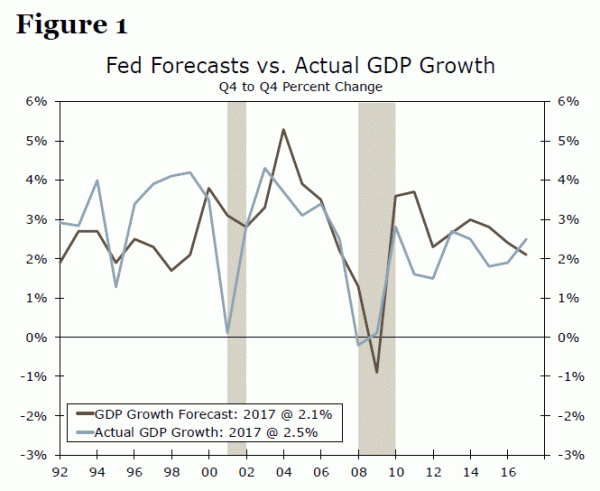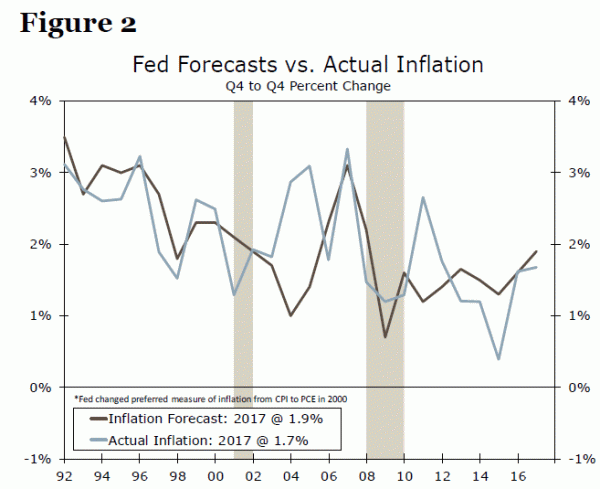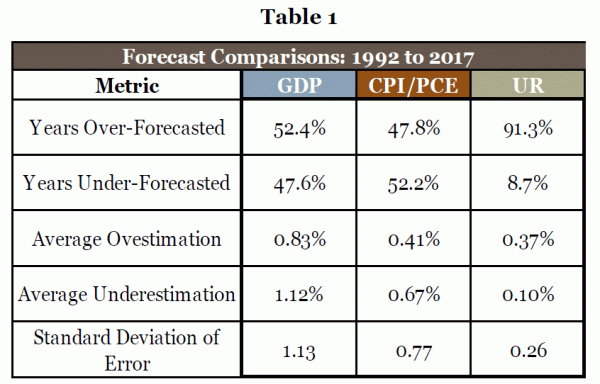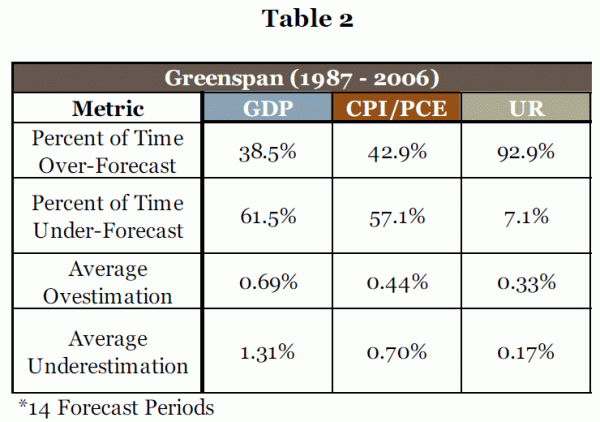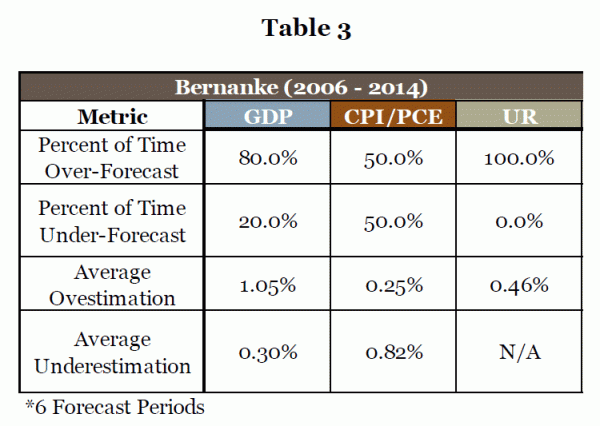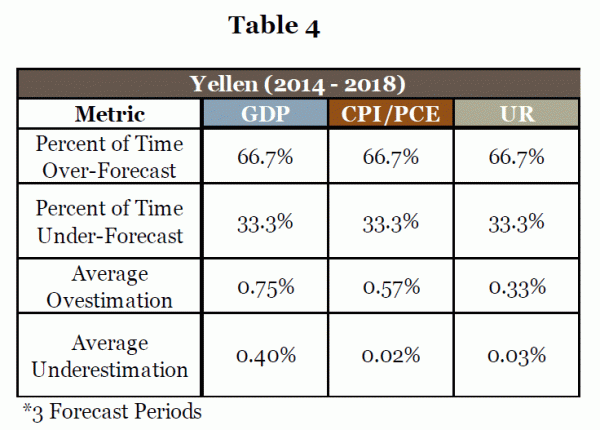“I am an optimist. Anyone interested in the future has to be otherwise he would simply shoot himself.” – Arthur C. Clarke
Executive Summary
Does the Federal Open Market Committee (FOMC) behave over-optimistically to achieve its objective? We propose a framework to find the answer. Recently, Federal Reserve Chairman Jerome Powell presented his semi-annual Monetary Policy Report to Congress. One of the important elements of the report, which is also the focus of this report, is the near-term forecasts of major economic and financial variables including GDP, inflation and the unemployment rate.
The importance of these forecasts can be divided into two groups. First, the FOMC utilizes its own forecasts in setting the stance of monetary policy. Second, the private sector, and financial market participants in particular, closely monitor these forecasts as signals of the economic outlook. The FOMC’s forecasts may also influence private sector expectations of the economic outlook.1 As forecasts seldom hit their targets, we must estimate the potential losses from forecast errors.
.We find that the FOMC tended to over-forecast GDP growth and the unemployment rate and under-forecast inflation during the 1992-2017 period (Figures 1 and 2). We also find that the FOMC’s forecasts displayed different behavior under different chairs. Our analysis also suggests that the FOMC is overly-optimistic, as it tends to forecast a more optimistic GDP growth outlook with “controlled” inflation expectations. Furthermore, its optimism has increased over time. And, outside of recessions, the FOMC never predicted negative or only slightly positive GDP growth.
The FOMC’s GDP growth and inflation forecasts also appear to be inconsistent with each other. One major reason for this inconsistency is that it may help the FOMC achieve its dual mandate. An overly-optimistic growth outlook while under-forecasting inflation would paint a “rosy” picture where the economy is growing close to its potential while also not overheating. Another potential explanation for this overly-optimistic behavior is that the FOMC “spreads” positive news, and these forecasts influence the private sector. If the FOMC forecasts a weaker outlook, some analysts could consider this a signal of a change in monetary policy stance and/or that a recession is imminent. Therefore, in our view, the FOMC has an incentive to avoid predicting a weaker economic outlook.
We plan to publish a three-part series of reports, with the first part focusing on the FOMC’s behavior and whether it is overly-optimistic. The second part will include the Blue Chip forecasts as a measure of private sector behavior and evaluate whether the FOMC is more optimistic than the Blue Chip. We will also examine whether the FOMC’s forecasts influence private sector forecasts. The final report will analyze whether the FOMC forecasts are consistent with its adopted monetary policy stance. For example, we will analyze whether an overly-optimistic outlook is consistent with neutral versus contractionary monetary policy.
A Theoretical Framework to Estimate the Cost of Forecast Error
To determine whether the FOMC is overly-optimistic, we first discuss a theoretical framework, which will help us evaluate the FOMC’s forecasts and answer the question of over-optimism. In practice, forecasts do not always hit their targets, and this creates a higher possibility of forecast errors. The total cost (potential damages/losses) of forecast errors is labeled as the loss function. Moreover, the forecast error can be divided into an under-forecast (the forecast is lower than the actual value) and an over-forecast (the forecast is higher than the actual value). The question then becomes whether the cost of under-forecasting is identical to the cost of over-forecasting, known as a symmetric loss function. If the cost of being wrong is not identical for under-/over-forecasts, then it is called an asymmetric loss function.
In the case of a symmetric loss function, a forecaster is indifferent between under- and over-forecasting. However, an asymmetric loss function has the potential to dictate a preference for forecast errors. If a forecaster knows that under-forecasting could cause more damage than over-forecasting, that forecaster may tend to over-forecast. We utilize a simple example of weather forecasting to illustrate the asymmetric loss function scenario. In our view, a weather forecaster would generally prefer to over-forecast inclement weather, all else equal. The forecaster would want to prepare the general public for impending severe weather, and could “inflate” the probability of an upcoming winter storm, for example. If the over-forecast never comes to fruition, besides reputation, it would cause relatively small losses in terms of business closures and evacuations. However, under-forecasting a storm that did indeed affect the area could cause serious damages, both in terms of loss of life and monetary losses. Therefore, in our view, weather forecasters have an incentive to over-forecast because of their asymmetric loss function.
We believe that the FOMC’s loss function is also asymmetric, as it would prefer to avoid under-forecasting economic growth, for example by avoiding making a recession forecast. We discuss the implications of this tendency in the following section.
The FOMC’s Loss Function: Is Predicting Recession Unsuitable?
The dual objective of the FOMC is price stability and fostering maximum employment. Naturally, the FOMC’s loss function would be to avoid recessions, bubbles, a run-up in prices or deflationary periods. As discussed earlier, the FOMC utilizes its own forecasts in setting the stance of monetary policy, and these forecasts also influence private sector expectations of the economic outlook.2 The potential consequences of the FOMC’s forecast errors include an unsuitable monetary policy stance and undesired signals to the private sector. We first analyze the potential consequences of under-and over-forecasting on monetary policy, and then highlight the implications for the private sector. We utilize GDP growth and inflation forecasts as a case study. We first discuss the potential cost of under-forecasting GDP growth and CPI, and then discuss the cost of over-forecasting these two variables. In this section, our discussion is theoretical, and in the next section we examine the FOMC’s actual forecasts.
In theory, under-forecasting GDP growth and inflation rates would create the possibility of an overly-accommodative monetary policy stance, which may fuel an asset price bubble. For example, if the FOMC forecasts relatively weaker GDP growth and lower inflation rates, the FOMC would follow an accommodative monetary policy stance to stimulate the economy and push inflation toward target, all else constant. If we analyze one-year ahead forecasts, the FOMC would learn roughly a year later about the result of under-forecasting GDP growth and inflation. However, the FOMC would need to set the policy stance in the near term using its forecasts, which would suggest an overly-accommodative policy stance. Assuming actual GDP growth and inflation turn out be stronger, this scenario would suggest that the implied monetary policy stance is over accommodative, potentially fueling an asset price bubble. We define an “overly-accommodative” monetary policy stance as an instance where the policy stance should have been neutral or tighter, but instead the FOMC follows an accommodative policy stance. This means that the fed funds target rate is lower than it should have been otherwise. Some analysts suggest that the monetary policy stance was overly accommodative during the 2002-2004 period, which partially contributed to the housing bubble.3
Conversely, over-forecasting GDP growth and inflation may turn monetary policy toward an overly-restrictive stance, which may result in an economic slowdown or recession, as borrowing costs would be overpriced. That is, over-forecasting GDP growth above its potential growth rate would put upward pressure on inflation. Theoretically, the FOMC would raise the fed funds rate to tame inflation and prevent the economy from overheating. Raising the fed funds rate would boost the cost of capital, as interest rates are an important element of borrowing costs. Assuming actual GDP growth and inflation are weaker than forecasted, the scenario would suggest an overly-restrictive monetary policy stance. By the same token, the fed funds target rate would be higher than it should be given the actual data. Overpriced borrowing costs and weaker demand would open the door for a slowdown or a recession, all else equal.
Romer and Romer (2000) suggest that the FOMC forecasts influence private sector forecasts, because typically the private sector modifies its forecasts in response to Fed signals. Therefore, under-/over-forecasting, in theory, has potential consequences for the private sector and for the economy. For example, under-forecasting GDP growth and inflation may make the private sector nervous. As suggested by Romer and Romer (2000), the private sector believes that the Fed has more information relative to other decision makers, and may view a weaker outlook as a signal for a potential slowdown or recession. Conversely, over-forecasting has the potential to make the private sector overly optimistic, which may fuel excessive growth and overheat the economy.
If the FOMC’s forecasts are consistently too optimistic or pessimistic, it could affect its forecast reputation and ability to influence expectations, in addition to an unsuitable monetary policy stance. Forecasting is a double-edged sword for the FOMC, and it would likely want to avoid forecasting extreme events such as bubbles or recessions, at least publicly. Similarly, under-forecasting key variables may make the private sector worried, which could also bring a slowdown or recession. In light of this proposed theoretical framework, we evaluate the FOMC’s actual forecasts.
Forecasts vs. Reality: Is Over-Optimism a Secret Weapon of the FOMC?
We utilize the FOMC’s forecasts for the 1992-2017 period.4 We start our analysis in 1992 to analyze three recent Fed chair tenures over the past 25 years, and examine the forecasts under different FOMC leadership. As recessions are difficult to predict, particularly one year ahead, we exclude the 2001 and 2008-2009 recessionary periods when evaluating the forecasts. However, there are three recoveries/expansions in our analysis, and we evaluate the FOMC’s behavior during these periods. We use an annual dataset with 23 observations for our analysis. We use a one-year-ahead forecast horizon, as long-term forecasting is inherently difficult and has the potential for larger forecast errors. The possibility of structural breaks/outliers is also higher in the long term. In our view, the FOMC gives more weight to the near-term outlook and actual data when setting the stance of monetary policy.
For the overall 1992-2017 period (excluding recessions), The FOMC over-forecasted GDP growth 52 percent of the time, the unemployment rate 91 percent of the time and under-forecasted inflation 52 percent of the time (Table 1). Since the 2001 recession, the FOMC over-forecasted GDP growth 75 percent of the time and under-forecasted inflation 57 percent of the time. However, for the pre- 2001 recession era (1992-2000), the FOMC under-forecasted GDP growth 78 percent of the time and over-forecasted inflation 56 percent of the time. On net, the FOMC displayed different forecasting behavior for the post-2001 recession period compared to the pre-2001 era. In addition, the FOMC over-forecasted GDP growth in the 2010-2012 period after the Great Recession. The motivation of over-forecasting in the early phase of a recovery/expansion would be to spread optimism.
Our analysis suggests that the FOMC is overly-optimistic, as it forecasts a stronger growth outlook with “controlled” inflation expectations. Its optimism has also grown over time, as the FOMC had a greater tendency to over-forecast GDP growth in the post-2001 period compared to the pre-2001 era. In addition, outside of recessions, the FOMC never predicted negative or only slightly positive GDP growth numbers. During the 1992-2017 period (excluding the Great Recession), the FOMC predicted GDP growth rates less than 2 percent three times, all in the 1990s. This means that the Bernanke and Yellen eras never forecasted below-2-percent GDP growth. However, excluding recessions, actual GDP growth dropped five times below 2 percent during the period. One potential reason for above-2-percent forecasts after the Great Recession is that the potential GDP growth rate was slightly below 2 percent (1.5 percent for the 2008-2017 period per CBO estimates).5 The FOMC may have been suggesting that the economy was growing above its potential growth rate, meaning that it was “healthy”.
Another interesting observation from the FOMC’s GDP growth and inflation forecasts is that the data suggest that the forecasts are inconsistent with each other. For example, in the 2001-2017 period the FOMC over-forecasted GDP growth 75 percent of the time but under-forecasted inflation 57 percent of the time. Higher growth rates should put upward pressure on prices, all else equal, and over-forecasting GDP growth would have coincided with over-forecasting inflation. However, the FOMC’s inflation and GDP growth forecasts disagree with each other. One major reason for this inconsistency and for the overly-optimistic behavior may be that it could help the FOMC achieve its dual mandate. Over-forecasting economic growth while under-forecasting inflation would paint a “rosy” picture where the economy is growing close to its potential, but growth would not create inflationary pressures in the near term.
Another potential justification for the FOMC’s overly-optimistic behavior is that the FOMC “spreads” positive news, as the FOMC’s forecasts influence private sector expectations. If the FOMC forecasts a weaker outlook, that would make the financial sector and other watchers of the Fed’s forecasts uncomfortable. Some of those participants may consider a weaker outlook a signal for upcoming changes in the near-term monetary policy stance and/or a recession. In our view, the FOMC has an incentive to avoid predicting a weaker economic outlook in the near term. Eisenhower once said that pessimism never won any battle, and by being overly-optimistic the FOMC seems to follow Eisenhower’s quote.
The Legend of Fed Leadership: Yes, the Chairperson Matters
Finally, we analyze the FOMC’s forecasts under different chairs, and find that the forecasts are different under different leadership. For example, under Greenspan, the FOMC under-forecasted GDP growth 62 percent of the time, inflation 57 percent of the time and over-forecasted the unemployment rate 93 percent of the time (Table 2). During the Bernanke era, the FOMC over-forecasted GDP growth 80 percent of the time and the unemployment rate 100 percent of the time, while inflation was split 50-50 between the percent of the time over-forecast and under-forecast (Table 3). Yellen’s leadership displayed different forecasts than Greenspan and Bernanke. Under Yellen, the FOMC over-forecasted GDP growth, inflation and the unemployment rate two-thirds of the time. (Table 4).
Conclusion: Setting Monetary Policy Is a Double-Edged Sword
The FOMC utilizes several tools to achieve its dual mandate, including its forecasts of major economic variables. Our analysis shows that the FOMC tends to project a “rosy” path of GDP growth and inflation close to target, which satisfies its dual mandate. In sum, the FOMC’s forecasts tend to be overly-optimistic. In the next report, we plan to include Blue Chip forecasts as a measure of private sector behavior, and we will examine whether the FOMC or the private sector is more optimistic. Our final report will analyze whether the FOMC’s forecasts are consistent with its adopted monetary policy stance during the 1992-2017 period.
Appendix: The Data
Our analysis utilizes 23 years of historical forecast data from the Fed’s Greenbook forecasts and the FOMC’s Summary of Economic Projections (SEP). As the FOMC did not begin publishing the SEP until 2012, we use the forecasts complied by the Fed staff in the Greenbook and given to the FOMC ahead of each meeting as a proxy for the FOMC’s forecasts from 1992-2012. Our three variables of interest are GDP growth, inflation and the unemployment rate.
For each variable, we take the one-year ahead forecast published in the December Greenbook/SEP of the prior year. For example, we use the December 1991 Greenbook to get the full-year 1992 forecast. For GDP growth, both the Greenbook and the SEP calculate the annual growth rate as the change from the fourth quarter of the prior year to the fourth quarter of the given year. For inflation, prior to 2000 the FOMC forecasted CPI inflation, and began forecasting the PCE deflator in 2000. We align our data with this addition, analyzing the CPI forecasts until 2000 and the PCE forecasts from 2000-2017, as the PCE deflator is what is forecasted in the SEP. The Greenbook/SEP forecasts for inflation are also the change from the fourth quarter of the prior year to the fourth quarter of the given year. For the unemployment rate, the Greenbook/SEP forecasts annual values are calculated as the average for the fourth quarter of the given year. While the FOMC began publishing the SEP in 2012, it forecasted only the central tendency and range of each variable until 2015, and only began publishing the median in 2015. From 2012-2014 we use the average of the central tendency for each variable, and begin using the median forecast for each variable in 2015.
Finally, we use actual data for each variable in the same form as the forecast calculation. For the GDP numbers, as the GDP data is subject to several revisions, we use the advance release full-year estimate for each year beginning in 1996. Prior to 1996, the historical GDP press release archives were not readily available, so we utilize historical GDP vintage data from the Federal Reserve Bank of Philadelphia6, again using the same fourth quarter to fourth quarter growth rate calculation. For years in which there were major GDP revisions that coincided with the Q4 release, we calculate the full year growth rate using the advance number for the current year and the first revision number for the prior year to account for the level change under the GDP revision.
1Romer, Christina, D., and David H. Romer. 2000. “Federal Reserve Information and the Behavior of Interest Rates.” American Economic Review, 90 (3): 429-457.
2 For more detail see Romer and Romer, 2000.
3 Iqbal, Azhar and Vitner, Mark. (2013). Did Monetary Policy Fuel the Housing Bubble? The Journal of Private Enterprise. Vol 29, pp 1-24.
4 For more detail about the data used in our analysis, please see the Appendix of this report.
5 For more detail about potential growth rates, see CBO’s website: https://www.cbo.gov/about/products/budget-economic-data
6 https://www.philadelphiafed.org/research-and-data/real-time-center/real-time-data/data-files/routput




